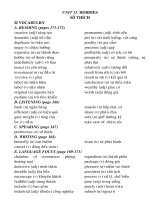UNIT 12 MARKETING (2)
Bạn đang xem bản rút gọn của tài liệu. Xem và tải ngay bản đầy đủ của tài liệu tại đây (107.1 KB, 6 trang )
Unit 12: MARKETING
SECTION 1: READING
PRE-READING TASKS
Discussion – Pair work
1. Here are four definitions of marketing. Which do you prefer?
• Selling means you sell what you make; marketing means you make what you can sell.
• Marketing means the right product, in the right place, at the right price, and at the right time.
• Marketing means identifying customers, defining and developing the products or services they want,
and making and distributing them.
• Marketing means anticipating and creating needs: producing useful things customers didn’t know
they wanted until you produced them.
2. Do you think a business can succeed without marketing? Why or why not?
Vocabulary preparation
Below are some basic marketing terms. Match up the words to the definitions.
distribution channel – marketing opportunities – market penetration – market segmentation –
market skimming – price elasticity – product differentiation –
product features – sales representative – wholesaler
1. all the companies or individuals (‘middlemen’) involved in moving goods or services from producers to
customers
2. an intermediary that stocks manufacturers’ goods or merchandise, and sells it to retailers and professional
buyers
3. dividing a market into distinct groups of buyers who have different requirements or buying habits
4. making a product (appear to be) different from similar products offered by other sellers, by product
differences, advertising, packaging, etc.
5. possibilities of filling unsatisfied needs in sectors in which a company can profitably produce goods or
services
6. setting a high price for a new product, to make maximum revenue before competing products appear on
the market
7. someone who contacts existing and potential customers, and tries to persuade them to buy goods or
services
8. the attributes or characteristics of a product, such as size, shape, quality, price, reliability, etc.
9. the extent to which supply or demand (the quantity produced or bought) of a product responds to changes
of price
10. the strategy of setting a low price to try to sell a large volume and increase market share
WHILE READING TASKS
Reading 1: The Product Life Cycle
Vocabulary
•
•
•
•
•
peak: reach the highest point/ value . . .
economies of scale: the reduction of production costs that is a result of making and selling goods in large
quantities, for example, the ability to buy large amounts of materials at reduced prices
liquidate /ˈlɪk.wə.deɪt/ (v): to cause a business to close, so that its assets can be sold to pay its debts
discontinue (v) = stop making/ selling
mature (adj)
maturity /məˈtʃʊə.rə.ti/ (n)
WHILE-READING TASKS
READING 1: THE PRODUCT LIFECYCLE
The graph shows the standard product life cycle. At the introduction stage, sales are low. They rise
quickly during the growth stage, level off at the maturity stage, before eventually falling during the
decline stage until the product is withdrawn from the market.
Which stages do the following sentences about sales, costs, prices and promotion describe?
1 Introduction stage
2 Growth stage
3 Maturity stage
4 Decline stage
Sales:
……… A. Public awareness about the product increases and sales volume rises significantly.
……… B. Sales volume peaks.
……… C. Sales volume begins to go down.
……… D. The sales volume is low and customers have to be persuaded to try the product.
Costs:
……… E. Costs are high.
……… F. The product’s features may have to be changed so that it differs from competing brands, which
involves new costs.
……… G. Costs are reduced due to economies of scale, so profitability increases.
……… H. Either costs are too high compared to sales, so the product is discontinued, or the company
continues to offer the product to loyal customers, while reducing costs to a minimum.
Prices:
……… I. The price is either maintained, or greatly reduced to liquidate stock if the product is discontinued.
……… J. The company can choose between high skim pricing to recover development costs, or low
penetration pricing to build market share rapidly, if there are already competitors.
……… K. The price can remain unchanged because demand is increasing but competitors aren’t usually yet
well established.
……… L. Prices may have to be reduced because competitors are established in the market, but companies
try to defend their market share while also maximizing profit.
Promotion:
……… M. Promotion emphasizes product differentiation.
……… N. Promotion is aimed at a much broader audience (the majority of the product’s users).
……… O. At this stage, there is virtually no promotion.
……… P. Promotion is aimed at educating potential consumers (innovators and early adopters) about the
product, and building product awareness.
2
READING 2: MARKETING IS EVERYTHING
Reading the following extracts from an article by Regis McKenna in the Harvard Business Review,
and do as directed.
Several decades ago, there were sales-driven companies. These organizations focused their energies on
changing customers’ minds to fit the product – practicing the ‘any color as long as it’s black’ school of
marketing.
As technology developed and competition increased, some companies shifted their approach and became
customer driven. These companies expressed a new willingness to change their product to fit customers’
requests – practicing the ‘tell us what color you want’ school of marketing.
Successful companies are becoming market driven, adapting their products to fit their customers’ strategies.
These companies will practice ‘Let’s figure out together how and whether color matters to your larger goal’
marketing. It is marketing that is oriented toward creating rather than controlling a market.
The old approach – getting an idea, conducting traditional market research, developing a product, testing the
market, and finally going to market – is slow and unresponsive.
As the demands on the company have shifted from controlling costs to competing on products to serving
customers, the center of gravity in the company has shifted from finance to engineering – and now to
marketing.
Marketing today is not a function; it is a way of doing business. Marketing is not a new ad campaign or this
month’s promotion. Marketing has to be all-pervasive, part of everyone’s job description, from the
receptionists to the board of directors. Its job is neither to fool the customer nor to falsify the company’s
image. It is to integrate the customer into the design of the product.
US companies typically make two kinds of mistake. Some get caught up in the excitement and drive of
making things, particularly new creations. Others become absorbed in the competition of selling things,
particularly to increase their market share in a given product line.
Both approaches could prove fatal to a business. The problem with the first is that it leads to an internal
focus. Companies can become so fixated on pursuing their R&D agendas that they forget about the
customer, the market, the competition.
The problem with the second approach is that it leads to a market-share mentality. It turns marketing into an
expensive fight over crumbs rather than a smart effort to own the whole pie.
The real goal of marketing is to own the market – not just to make or sell products. Smart marketing means
defining the whole pie as yours. In marketing, what you lead you own. Leadership is ownership.
That is why marketing is everyone’s job, why marketing is everything and everything is marketing.
VOCABULARY LIST
• market-driven = market led: influenced by market knowledge and customer needs
• customer-driven = paying great attention to finding out what customers want and helping them to get it.
• to fit = to be suitable for something
• shift from . . . to . . . = change from . . . to . . .
• adapt . . . to . . . = change something to suit to different conditions/ uses
• matter (v) to . . . = be important to …
• oriented toward . . . = showing the direction in which something is aimed.
• unresponsive (adj) = not reacting quickly or positively / not answering
• gravity (n) = seriousness
• all-pervasive = present or noticeable in every part of thing / place
• to fool s.o. = to trick s.o
• to falsify = to change something to deceive people
• to integrate /ˈɪn.tɪ.ɡreɪt/ . . . into = to combine two or more things in order to become more effective
• get caught up in . . . = become unexpectedly involved in an unpleasant or annoying situation
• drive (n) = a planned effort to achieve something
• absorbed in= interested in and not paying attention to anything else.
• fatal /ˈfeɪ.təl/ (adj) = very serious and having an important bad effect in the future.
• fixated (adj) = unable to stop thinking about something / focused solely on one thing/ person
• agenda /əˈdʒen.də/ = a list of aims/ possible future achievements
• mentality (n)= a person’s particular way of thinking
3
Answer these questions
1. List the marketing approaches mentioned in the text
………………………..
……………………….
………………………..
2. According to McKenna, what did sales-driven companies try to do?
……………………………………………………………………………………………………….
……………………………………………………………………………………………………….
3. Why did some companies become customer driven?
…………………………………………………………………………………………………….
……………………………………………………………………………………………………….
4. What does he say market-driven companies do?
……………………………………………………………………………………………………….
……………………………………………………………………………………………………….
5. What does McKenna mean when he describes the old approach as “unresponsive”?
……………………………………………………………………………………………………….
……………………………………………………………………………………………………….
6. What two negative descriptions of marketing does he reject?
……………………………………………………………………………………………………….
……………………………………………………………………………………………………….
7. What does he say about customers and market-driven companies?
……………………………………………………………………………………………………….
……………………………………………………………………………………………………….
8. What is wrong with focusing on R&D (research and development) and creating new products?
……………………………………………………………………………………………………….
……………………………………………………………………………………………………….
9. What is wrong with focusing on increasing market share?
……………………………………………………………………………………………………….
……………………………………………………………………………………………………….
10. Read paragraph 5 “As the demands . . . marketing” and match Column A with Column B
The company’s focus in terms of marketing
1. Controlling costs
2. Competing on products
3. Serving customers
The company’s importance in terms of operation
a. Engineering
b. Marketing
c. Finance
Make the right choice
1. What does “Engineering” imply?
a. improving the quality of the products with high technology
b. employing skillful engineers
c. installing modern machinery
d. all of the above
2. In terms of marketing, the purpose of controlling costs is ____________________.
a. to make the unit costs of the products as low as possible.
b. to reduce the employees’ salary
c. to lower the overhead
d. to reduce the advertising budget of the company
3. According to the text, marketing has to be all-pervasive, part of everyone’s job description. This implies _________ .
a. everyone must work as marketers.
b. everyone must work for the marketing department
c. everyone must involve in selling products
d. marketing is represented by all the activities of a business
4
True or False?
4. Marketing is equivalent to advertising.
5. A cleaner’s job also serves marketing.
Fill each gap with one of these two terms: sales driven or market-oriented
6. The primary goal for a ____________ company is the highest possible profit in the shortest amount of time.
7. A ____________ business seeks to develop product lines and offer services that can attract consumer interest for
the long term.
POST-READING TASKS
Discussion – Pair work
1. Do you think Regis McKenna’s account of the role of marketing is realistic?
2. Would it work for all industries and markets, or only particular ones?
Vocabulary in new contexts
Fill in each gap with a suitable word/ phrase from the box.
fatal – integrate – oriented – discontinued – agenda - liquidates – unresponsive –
economies of scale – got caught up – drive – absorbed – mentality – maturity – fixated - peak
1. He ………………… in the demonstrations and was then arrested.
2. The slightest mistake may lead to a …………….. disaster
3. Shirali works to help new arrivals ……………… into society by offering practical help and advice.
4. HCMC University of Economics is now a research-…………….. university.
5. The online learning system will be …………….. by the end of this week. Remember to access it as
soon as possible or else you will fail to fulfil your homework.
6. The subject of safety needs to be placed high on/at the top of the ……………….
7. So ……………. was she in thought that she didn't notice when he entered the room.
8. We are on an economy …………….. at the moment, so we are trying not to spend too much on nonessential things.
9. She is very disappointed since the company has been ………………. to her efforts to discuss a
settlement.
10. Credit card companies understand the ………………… of some cardholders, and they also
understand that a generous rewards program can prompt certain people to spend money.
11. When a furniture store sells off its inventory and goes out of business, this is an example of when it
………………….
12. Thanks to …………………………., the per-unit costs can be reduced.
13. When you can show common sense and make adult decisions, you have achieved the
………………………..
14. There was a sharp ………………. in housing prices a few years ago.
15. If you are so …………………… in such a detail, you are looking at the tree instead of seeing the
whole forest.
5
SECTION 2: LISTENING
Listening 1: Promoting a juice bar. Listen to Melissa Glass explaining how Zeste tried to promote
their juice bar, and answer the questions.
1. What was the first form of marketing (or promotion) they tried?
……………………………………………………………………………………………………………
2. Why were they sure it would work?
…………………………………………………………………………………………………………………
………………………………………………………………………………………………………
3. What concept was used for the advertising campaign, and what was the problem with it?
…………………………………………………………………………………………………………………
………………………………………………………………………………………………………
Listening 2: The most effective form of promotion. Listen to Melissa Glass talking about a
successful form of promotion, and answer the questions.
1. According to Melissa, what is the most effective form of promotion?
……………………………………………………………………………………………………………
2. Does it have a temporary or a permanent effect?
…………………………………………………………………………………………………………………
………………………………………………………………………………………………………
3. Why do you think this form of promotion works better than advertising?
…………………………………………………………………………………………………………………
………………………………………………………………………………………………………
Listen to the recordings again and fill in the blanks with the words you hear.
Listening 1
-- After the launching of Zeste, it was quite (1) ……………….. They found different ways of (2)
……………….. customers and different forms of marketing.
-- The first tactic was (3) ……………….. They got people try their products on the street. They believe that
the customers will feel (4) ……………….. and their product sells itself as far as (5) ………………… The
first tactic was quite (6) ………………… However, because the season then was (7) ……………….. and
the foot traffic was less, they decided to do some sort of advertising, something (8) ………………... to touch
the customers.
-- The second tactic unfortunately was a very (9) ……………….. experience. They went through a design
(10) ……………….. to design posters to go into the buses because the bus actually passed directly in front
of their store. The second tactic was costly partly because of the design, the production and the printing of
the (11) ………………...
-- The theme of the campaign was ‘Get a kick out of your (12) ………………... and come to Zeste.’
Unfortunately, because there wasn’t enough (13) ………………... about the product in the pamphlet and the
Swiss didn’t know what a (14) ……………….. was, the advertising campaign was not (15) ………………...
Listening 2
The most effective thing they’ve found is (1) ……………….. in the papers. Therefore, they spends a lot of
time contacting the (2) ……………….. and papers like the free ones in the morning, and trying to get free
(3) ………………... because they know that papers are often keen to have new things, or new information.
Although they hit the target straight away and the effect is (4) ………………..., those articles are only
effective in one or two days. The idea behind this tactic is that they (5) ……………….. customers by the
product and the taste of the product, and that customers will come back because of the product itself.
6









